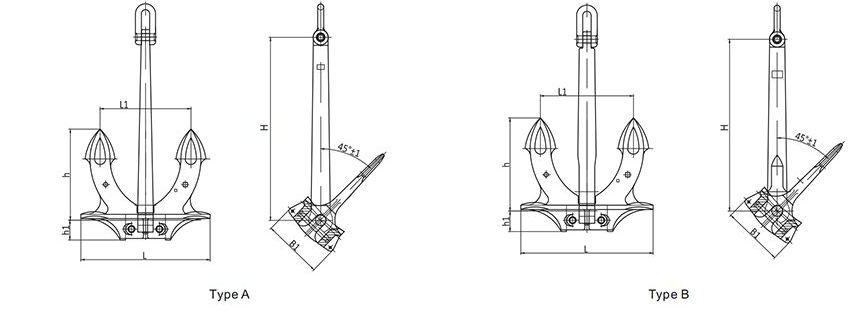This is the most basic performance requirement. The characteristic value to measure the holding performance of Marine anchor is usually called the holding force coefficient. The anchor’s holding coefficient is equal to the anchor’s holding force in the subsoil divided by the anchor’s mass in the air. As a rule, the greater the weight of the anchor, the greater its holding power; However, the holding force coefficient of most anchors decreases with the increase of their mass. Therefore, full attention should be paid to this characteristic when determining the holding force of anchors.
Product Details
Hall anchor Type A, B, C despcrition:
Large grasping force: this is the most basic performance requirement. The characteristic value to measure the holding performance of Marine anchor is usually called the holding force coefficient. The anchor’s holding coefficient is equal to the anchor’s holding force in the subsoil divided by the anchor’s mass in the air. As a rule, the greater the weight of the anchor, the greater its holding power; However, the holding force coefficient of most anchors decreases with the increase of their mass. Therefore, full attention should be paid to this characteristic when determining the holding force of anchors.
Can adapt to a variety of different bottom quality: general ships due to the vast sailing area, the bottom quality situation changes greatly, so the configuration of the anchor type requirements can adapt to a variety of bottom quality.
Strong structure: the ship may bear a variety of complex loads in the process of anchoring, hoisting and tying, so the structure of the anchor should be strong to ensure its safe use.
Good stability, easy to soil: the ship in the anchoring process, due to the change of the wind direction and flow of the ship around the anchor point rotation, uneven bottom material makes the anchor jaw uneven force, resulting in the anchor turned over and was pulled out of the bottom soil, so good stability is very important for the anchor. Usually, the anchor with a transverse bar is more stable, but it will make the anchors inconvenient to collect. Under certain circumstances, such as a ship turning or a sudden increase in load, the anchor may still be pulled out of the subsoil, so it is required to have the characteristic of re-burrowing into the subsoil.
Hall anchor Type A, B, C Specification:

| NORMINAL WEIGHT(kg) | SIZE(mm) | |||||||
| H | h | h1 | L | L1 | B1 | |||
| A Type | B Type | C Type | ||||||
| 40 | 557 | 557 | 430 | 303 | 67 | 450 | 303 | 198 |
| 60 | 637 | 637 | 492 | 347 | 76 | 492 | 347 | 227 |
| 100 | 760 | 760 | 590 | 410 | 90 | 584 | 410 | 270 |
| 125 | 814 | 814 | 629 | 443 | 97 | 629 | 443 | 290 |
| 150 | 866 | 866 | 665 | 470 | 103 | 670 | 470 | 308 |
| 180 | 919 | 919 | 718 | 500 | 110 | 710 | 500 | 327 |
| 240 | 1019 | 1019 | 788 | 552 | 121 | 784 | 552 | 361 |
| 300 | 1095 | 1095 | 850 | 595 | 130 | 844 | 595 | 388 |
| 360 | 1160 | 1160 | 898 | 630 | 138 | 898 | 630 | 412 |
| 420 | 1160 | 1160 | 946 | 660 | 145 | 946 | 660 | 434 |
| 480 | 1222 | 1222 | 986 | 690 | 152 | 988 | 690 | 454 |
| 570 | 1355 | 1355 | 1042 | 732 | 161 | 1042 | 732 | 481 |
| 660 | 1356 | 1356 | 1093 | 769 | 169 | 1096 | 769 | 506 |
| 780 | 1506 | 1506 | 1170 | 813 | 178 | 1160 | 813 | 535 |
| 900 | 1580 | 1580 | 1215 | 855 | 188 | 1220 | 855 | 560 |
| 1020 | 1645 | 1645 | 1268 | 891 | 195 | 1268 | 891 | 584 |
| 1140 | 1705 | 1705 | 1316 | 926 | 203 | 1319 | 926 | 605 |
| 1290 | 1778 | 1778 | 1378 | 965 | 211 | 1374 | 965 | 630 |
| 1440 | 1844 | 1844 | 1448 | 1001 | 219 | 1430 | 1001 | 655 |
| 1590 | 1906 | 1906 | 1511 | 1035 | 226 | 1475 | 1035 | 677 |
| Contact to us to get more size specification | ||||||||
Copyright © Whale Marine Product Co.,Ltd. All Rights Reserved | Sitemap| Powered by 